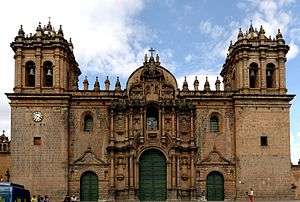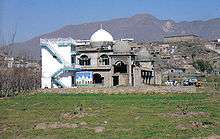Religion in Peru
Christianity is the largest religion in Peru, with Roman Catholics having the most adherents. Religion in Peru is traditionally related to religious syncretism originating from Catholicism with the ancient Inca religion after the Spanish Conquest. However, Protestant churches of various denominations have developed considerably in the popular sectors over the past 30 years. There has been a slow but consistent advance of irreligion especially among young people in urban areas. Religions such as Judaism and Buddhism, and more recently Hinduism and Islam, are present due to immigration.
| This article is part of a series on the |
| Culture of Peru |
|---|
_alternative_version.svg.png) |
|
History
RecentPresidency of Martín Vizcarra (2018-current) |
|
Arts and literature
|
|
Entertainment
|
|
|
|
Peru portal |
According to article 2 of the Peruvian Constitution: "Everyone has the right to freedom of conscience and religion, individually or in association. There is no persecution for reasons of ideas or beliefs. There is no crime of opinion. The public exercise of all confessions are free, as long as they do not offend morals or disturb public order."[2]
Christianity
Roman Catholicism
History
The Spanish conquerors not only conquered Peru militarily, but also sought to convert the indigenous populations to Christianity. Indigenous Andean religious beliefs and practices persisted, which the Catholic Church sought to suppress.[3][4][5] Many churches were built in the colonial period, the visible manifestation of Catholicism.[6][7][8][9][10][11] Some convents were also built on Inca sites. For example, in 1605, some Dominican nuns built the Convent of Santa Catalina in Cuzco atop the site of the "acllahuasi", once home to virginal young women dedicated to serving the ruling Inca. Another convent, the Convent of Santa Clara, was one of the first institutions the conquistadores of Cuzco built for "Indian nobles", the daughters of the indigenous elite whose collaboration made Spain's indirect rule over the Andes possible.[12] At Santa Clara, Inca nobles were to be "raised Christian and to receive 'buenas costumbres' (literally, good customs or manners), shorthand for an education in Spanishness", which included knowledge, stitchery, and literacy. After graduating from this course in Spanish culture, charges were free to profess vows or leave the convent.[13] Miscegenation was not an issue among Spaniards. Many prominent Spanish men lived with elite Inca women, only to marry Spanish women later in life and marry off their Andean partners to less prominent Spaniards.[14]
Modern era
The Peruvian government is closely allied with the Catholic Church. Article 50 of the Constitution recognizes the Catholic Church's role as "an important element in the historical, cultural, and moral development of the nation." [15] Catholic clergy and laypersons receive state remuneration in addition to the stipends paid to them by the Church. This applies to the country's 52 bishops, as well as to some priests whose ministries are located in towns and villages along the borders. In addition each diocese receives a monthly institutional subsidy from the Government. An agreement signed with the Vatican in 1980 grants the Catholic Church special status in Peru.[16] The Catholic Church receives preferential treatment in education, tax benefits, immigration of religious workers, and other areas, in accordance with the agreement. So Roman Catholicism could be considered the main religion of Peru. See also the following: Roman Catholicism in Peru with Partial list of Catholic universities in Peru; and Lord of Miracles, Peruvian religious festival.
Although the Constitution states that there is freedom of religion, the law mandates that all schools, public and private, impart religious education as part of the curriculum throughout the education process (primary and secondary).[17] Catholicism is the only religion taught in public schools. In addition, Catholic religious symbols are found in all government buildings and public places.
According to the 2017 Census, there were 76% of the population 12+ identifying themselves as Catholics.
Protestants
At the 2017 Census there were 14.1% of the population 12+ identifying themselves as Protestants, mainly Evangelicals. In Latin America most Protestants are called Evangelicos because most of them are Evangelical Protestants, while some are also traditional Mainline Protestant. They continue to grow faster than the national growth rate.
Irreligion
According to the 2017 Peruvian Census data, 1'180.361 Peruvians or 5.1% of the population older than 12 years old describes themselves as being irreligious,[18] but some sources put this number higher at 8.2%.[19]
The irreligious population is predominantly urban (85,5% live in cities) and males (61,4% are male), and most are young people within the ages between 18 and 29 (40,4%). Only 11,8% of irreligious people are 50 years old or older.[18]
Even though Peru is considered to be a Secular state, according to article 50 of the Peruvian Constitution[2] the subject of Roman Catholicism is mandatory in Peruvian public schools.[20] Many non-profit organizations promote the removal of the subject of Roman Catholicism in public schools, such as the Secular Humanist Society of Peru.[21]
Other religions in Peru
The Church of Jesus Christ of Latter-day Saints
The Church of Jesus Christ of Latter-day Saints claims more than 578,000 members in Peru.[22][23] There are currently 764 congregations that meet in Peru.[23]
There are currently two LDS temples in Peru, one located in La Molina, Lima, and the other in Trujillo. On October 6, 2012, the LDS church announced a third temple to be built in Arequipa.[24] At the April 3, 2016 General Conference of the LDS church, it was announced that a fourth temple would be built in Los Olivos, Lima.[25] This second temple in Lima will make the city one of the few in the world with two temples. Peru is also home to more than 100 stakes of the LDS church.
Buddhism
Buddhism was introduced to Peru in 1899 when the ship Sakura Maru arrived at Callao, Peru, with 790 people from Japan. Japanese, Chinese, and Korean immigration to Peru during the 19th and 20th Century brought Mahayana Buddhism to Peru, and followers of that style of Buddhism remain largely concentrated within those ethnic groups. While Mahayana remains the largest school of Buddhism in Peru, other schools such as the Diamond form have begun to spread so that Peru has more than 50,000 practicing Buddhists.
Bahá'í Faith
The Bahá'í Faith in Peru begins with references to Peru in Bahá'í literature as early as 1916, with the first Bahá'ís visiting as early as 1919. A functioning community wasn't founded in Peru until the 1930s with the beginning of the arrival of coordinated pioneers from the United States[26] which progressed into finding national Peruvian converts and achieved an independent national community in 1961.[27] The Association of Religion Data Archives (relying mostly on the World Christian Encyclopedia) estimated some 41,000 Bahá'ís in 2005.[28]
Notes
- 14.07% Evangelical, 1.64% Non-denominational Christian, 1.52% Adventist, 0.75% Jehovah's Witness and 0.49% Mormon.
References
- "Perú: Perfil Sociodemográfico" (PDF). Instituto Nacional de Estadística e Informática. p. 231.
- "Political Constitution of Peru" (PDF). Portal Institucional e Información sobre la Actividad Parlamentaria y Legislativa del Estado Peruano. September 2009. Retrieved May 15, 2020.
- Kenneth Mills, Idolatry and Its Enemies: Colonial Andean Religion and Extirpation, 1640-1750. Princeton: Princeton University Press, 1997.
- Susan E. Ramírez, To Feed and Be Fed: The Cosmological Bases of Authority and Identity in the Andes. Stanford: Stanford University Press 2005.
- Carolyn Dean, Inka Bodies and the Body of Christ: Corpus Christi in Colonial Cuzco, Peru. Durham: Duke University Press 1999.
- Damián Bayon and Murillo Marx, History of South American Colonial Art and Architecture. New York: Rizzoli 1989.
- Harold Wethey, Colonial Architecture and Sculpture in Peru. Cambridge: Harvard University Press 1949.
- Alfredo Benavides Rodríguez, La arquitectura en el Virreinato del Perú y en la Capitanía General de Chile. 3rd edition’’. Santiago de Chile: Andrés Bello 1988.
- Antonio San Cristóbal Sebastián, Arquitectura virreinal religiosa de Lima. Lima: stadium 1988.
- Valerie Fraser. The Architecture of Conquest: Building in the Viceroyalty of Peru, 1535-1635. Cambridge: Cambridge University Press 1989.
- Teresa Gisbert and José de la Mesa, Arquitectura andina, 1500-1830. 2nd edition. La Paz: embajada de España en Bolivia 1997.
- Burns, Kathryn (1999). Colonial Habits: Convents and the Spiritual Economy of Cuzco, Peru (2nd ed.). Durham, North Carolina: Duke University Press. p. 2. ISBN 9780822322917.
- Burns, 27.
- Burns, 21.
- International Religious Freedom Report 2007; Bureau of Democracy, Human Rights, and Labor; Published by U.S. State Department. Page 15
- Kevin Boyle and Juliet Sheen, Freedom of religion and belief: a world report. Routledge; 1997. Page 144.
- Michael Fleet and Brian H. SmithThe Catholic Church and democracy in Chile and Peru. University of Notre Dame Press; 1997. Page 201-202.
- "Perú: Perfil Sociodemográfico - Informe Nacional" (PDF). Instituto Nacional de Estadística e Informática. August 2018.
- "La visita del Papa Francisco a nuestro país" (PDF). Compañía Peruana de Estudios de Mercados y Opinión Pública. February 2018. Retrieved May 15, 2020.
- "Perú: niegan retiro de clases de religión en los colegios públicos". February 2017. Retrieved May 15, 2020.
- Perú, Redacción El Comercio (October 27, 2018). "Más de un millón de peruanos no profesan ninguna religión". El Comercio Perú. Retrieved May 15, 2020.
- "LDS Newsroom -Peru". Beta-newsroom.lds.org. 2011-12-24. Retrieved 2012-10-20.
- "Peru". Church News. 2016-09-24. Retrieved 2016-09-20.
- "Trujillo Peru Temple". LDS Church Temples. Retrieved 2012-10-20.
- "Lima Peru Los Olivos Temple". churchofjesuschristtemples.org. Retrieved 2018-04-04.
- Lamb, Artemus (November 1995). The Beginnings of the Bahá'í Faith in Latin America:Some Remembrances, English Revised and Amplified Edition. 1405 Killarney Drive, West Linn OR, 97068, United States of America: M L VanOrman Enterprises.CS1 maint: location (link)
- The Bahá'í Faith: 1844-1963: Information Statistical and Comparative, Including the Achievements of the Ten Year International Bahá'í Teaching & Consolidation Plan 1953-1963. Haifa, Israel: Hands of the Cause Residing in the Holy Land. 1963. pp. 19, 22, 23, 36, 46, 52, 109.
- "Most Baha'i Nations (2005)". QuickLists > Compare Nations > Religions >. The Association of Religion Data Archives. 2005. Retrieved 2009-07-04.
- Shaikh, Farzana. "Islam and Islamic groups: a worldwide reference guide", 1992
- "Islam in Latin America" (PDF). Retrieved 2012-10-20.
- Phoenice, Ariel (2011-11-22). "Información de la Religión Wicca Tradición Sajona". Worldwide Wicca. Wordpress. Archived from the original on 2012-02-09.

